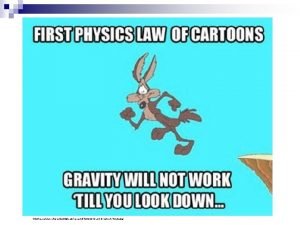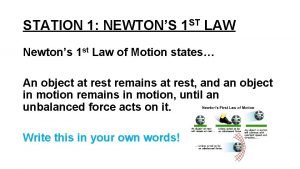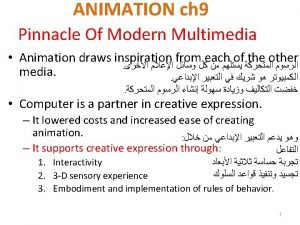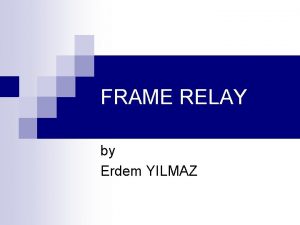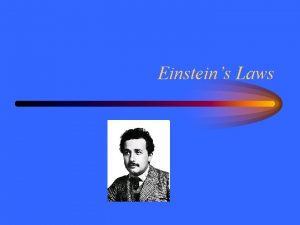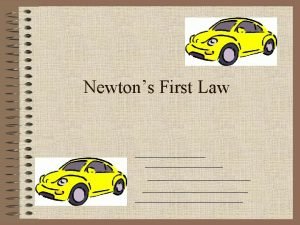Reference Frame First Law Newtons first law says

![First Law ] Newton’s first law says that with no net force there is First Law ] Newton’s first law says that with no net force there is](https://slidetodoc.com/presentation_image_h2/394323c395e1db00908115a9c24f33b8/image-2.jpg)
![Inertial Frame ] An observer on the table sees two ball fall. • First Inertial Frame ] An observer on the table sees two ball fall. • First](https://slidetodoc.com/presentation_image_h2/394323c395e1db00908115a9c24f33b8/image-3.jpg)
![Accelerated Frame ] A rotating observer throws a ball across a merry-go-round. • Ball Accelerated Frame ] A rotating observer throws a ball across a merry-go-round. • Ball](https://slidetodoc.com/presentation_image_h2/394323c395e1db00908115a9c24f33b8/image-4.jpg)
![Galilean Relativity ] An event is a point in space and time. • Described Galilean Relativity ] An event is a point in space and time. • Described](https://slidetodoc.com/presentation_image_h2/394323c395e1db00908115a9c24f33b8/image-5.jpg)
![Relative Velocity ] The Galilean transformation provides a conversion for relative velocity. y S Relative Velocity ] The Galilean transformation provides a conversion for relative velocity. y S](https://slidetodoc.com/presentation_image_h2/394323c395e1db00908115a9c24f33b8/image-6.jpg)
![Moving Light ] Light as a wave should have a medium for transmission. ether Moving Light ] Light as a wave should have a medium for transmission. ether](https://slidetodoc.com/presentation_image_h2/394323c395e1db00908115a9c24f33b8/image-7.jpg)
![Universal Constant ] Maxwell’s equations assume a constant value for c. • Independent of Universal Constant ] Maxwell’s equations assume a constant value for c. • Independent of](https://slidetodoc.com/presentation_image_h2/394323c395e1db00908115a9c24f33b8/image-8.jpg)
- Slides: 8

Reference Frame
![First Law Newtons first law says that with no net force there is First Law ] Newton’s first law says that with no net force there is](https://slidetodoc.com/presentation_image_h2/394323c395e1db00908115a9c24f33b8/image-2.jpg)
First Law ] Newton’s first law says that with no net force there is no acceleration. • Objects at rest • Objects at constant velocity ] If there is no observed acceleration on an object with no net force, the observer is in an inertial reference frame. • Newton’s laws of mechanics apply equally • No absolute motion
![Inertial Frame An observer on the table sees two ball fall First Inertial Frame ] An observer on the table sees two ball fall. • First](https://slidetodoc.com/presentation_image_h2/394323c395e1db00908115a9c24f33b8/image-3.jpg)
Inertial Frame ] An observer on the table sees two ball fall. • First straight down • Second in a parabola ] An observer with speed vx 0 sees the reverse. • Second straight down • First in a backwards parabola ] Both frames are inertial. • Motion consistent with Newton
![Accelerated Frame A rotating observer throws a ball across a merrygoround Ball Accelerated Frame ] A rotating observer throws a ball across a merry-go-round. • Ball](https://slidetodoc.com/presentation_image_h2/394323c395e1db00908115a9c24f33b8/image-4.jpg)
Accelerated Frame ] A rotating observer throws a ball across a merry-go-round. • Ball veers to the side • No external force ] This is a non-inertial frame. • Observed motion inconsistent with Newton’s laws • Fictitious forces
![Galilean Relativity An event is a point in space and time Described Galilean Relativity ] An event is a point in space and time. • Described](https://slidetodoc.com/presentation_image_h2/394323c395e1db00908115a9c24f33b8/image-5.jpg)
Galilean Relativity ] An event is a point in space and time. • Described by coordinates: (x, y, z, t) ] A different frame of reference uses different coordinates. ] The Galilean transformation converts between two inertial frames. • Coincide at t = 0 y S y’ S’ v Event P x x’
![Relative Velocity The Galilean transformation provides a conversion for relative velocity y S Relative Velocity ] The Galilean transformation provides a conversion for relative velocity. y S](https://slidetodoc.com/presentation_image_h2/394323c395e1db00908115a9c24f33b8/image-6.jpg)
Relative Velocity ] The Galilean transformation provides a conversion for relative velocity. y S y’ P • Moving event P • Observed velocity u, u’ x v S’ u’ u x’
![Moving Light Light as a wave should have a medium for transmission ether Moving Light ] Light as a wave should have a medium for transmission. ether](https://slidetodoc.com/presentation_image_h2/394323c395e1db00908115a9c24f33b8/image-7.jpg)
Moving Light ] Light as a wave should have a medium for transmission. ether • Like a plane in the wind • Speed in ether c light observed ] The ether velocity and the light velocity must add to get the result from the earth.
![Universal Constant Maxwells equations assume a constant value for c Independent of Universal Constant ] Maxwell’s equations assume a constant value for c. • Independent of](https://slidetodoc.com/presentation_image_h2/394323c395e1db00908115a9c24f33b8/image-8.jpg)
Universal Constant ] Maxwell’s equations assume a constant value for c. • Independent of motion • Independent of observer ] Mechanical waves should follow Galilean relativity. • Speed depends on observer’s relative motion ] This was the paradox of the “ether”. • Newton and Maxwell contradict next

